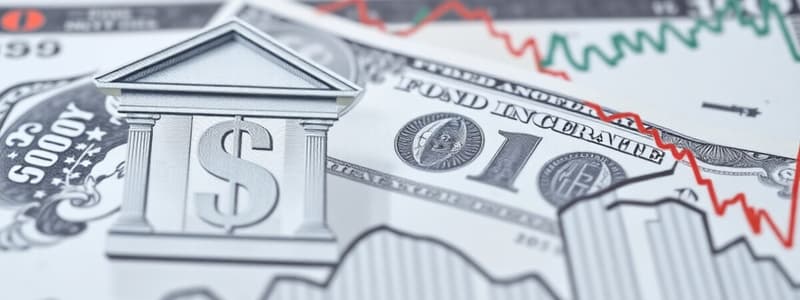Podcast
Questions and Answers
Which of the following types of debt securities protect investors against interest rate risk?
Which of the following types of debt securities protect investors against interest rate risk?
- floating rate bonds and extendible notes (correct)
- extendible notes
- floating rate bonds
- original issue deep discount bonds
Zero coupon bonds are an example of
Zero coupon bonds are an example of
- convertible bonds
- extendible notes
- original issue deep discount bonds (correct)
- floating rate notes
Original issue deep discount bonds have decreased in popularity over the last several years due to:
Original issue deep discount bonds have decreased in popularity over the last several years due to:
- issuance by brokerage firms of lower risk substitutes
- changes in tax laws
- increased interest in equity securities
- changes in tax laws and issuance by brokerage firms of lower risk substitutes (correct)
Extendable notes are redeemable at par at the option of the
Extendable notes are redeemable at par at the option of the
If a firm could sell a mortgage bond at an 8% interest rate, it could sell an otherwise identical debenture at
If a firm could sell a mortgage bond at an 8% interest rate, it could sell an otherwise identical debenture at
When the market for an asset is in equilibrium, the expected rate of return on the asset is equal to the:
When the market for an asset is in equilibrium, the expected rate of return on the asset is equal to the:
The ______ the investor's required rate of return on a bond, the ______ will be the value of the bond to the investor.
The ______ the investor's required rate of return on a bond, the ______ will be the value of the bond to the investor.
The yield-to-maturity of a bond with a finite maturity date is a function of all of the following variables except:
The yield-to-maturity of a bond with a finite maturity date is a function of all of the following variables except:
The value of a perpetual bond is equal to the annual interest payment divided by the:
The value of a perpetual bond is equal to the annual interest payment divided by the:
Which of the following statements concerning preferred stocks is true?
Which of the following statements concerning preferred stocks is true?
Rank in ascending order (lowest to highest) the relative risk associated with holding the preferred stock, common stock and bonds of a firm:
Rank in ascending order (lowest to highest) the relative risk associated with holding the preferred stock, common stock and bonds of a firm:
By the capitalization-of-cash flows method, the value of an asset is a function of
By the capitalization-of-cash flows method, the value of an asset is a function of
Which of the following is not a characteristic of long-term debt?
Which of the following is not a characteristic of long-term debt?
The quality of a debenture depends on the
The quality of a debenture depends on the
The indenture is a contract between the issuer and lenders that does all the following except:
The indenture is a contract between the issuer and lenders that does all the following except:
The call feature of a long-term bond
The call feature of a long-term bond
A sinking fund allows the issuer to
A sinking fund allows the issuer to
Normally the coupon rates on new bonds
Normally the coupon rates on new bonds
Junk bonds are
Junk bonds are
Large companies build up short-term debt over the period of 1 to 2 years, then sell long-term debt using a portion of the proceeds to repay the short-term borrowings. This procedure is called:
Large companies build up short-term debt over the period of 1 to 2 years, then sell long-term debt using a portion of the proceeds to repay the short-term borrowings. This procedure is called:
The major advantages of long-term debt include all the following except:
The major advantages of long-term debt include all the following except:
The value of a 15-year bond will change ______ for a given change in the required rate of return than the value of a 5 year bond.
The value of a 15-year bond will change ______ for a given change in the required rate of return than the value of a 5 year bond.
When the required rate of return is ______ the coupon rate, the bond will sell at a discount.
When the required rate of return is ______ the coupon rate, the bond will sell at a discount.
Equipment trust certificates are used mainly by
Equipment trust certificates are used mainly by
All of the following types of bonds are secured except
All of the following types of bonds are secured except
The call feature is an advantage to the issuing firm
The call feature is an advantage to the issuing firm
Which of the following is the highest risk debt issue?
Which of the following is the highest risk debt issue?
The ______ represents the debtholders in dealings with the issuing company.
The ______ represents the debtholders in dealings with the issuing company.
If an American Water Company bond has a coupon rate of 9.0 percent and is selling for $920, then the yield to maturity must be:
If an American Water Company bond has a coupon rate of 9.0 percent and is selling for $920, then the yield to maturity must be:
“Junk bond” is a term used to describe a bond that
“Junk bond” is a term used to describe a bond that
The basic relationship in bond valuation is for a given percentage point change in the required rate of return, the ______ the time to maturity, the ______ the change in value.
The basic relationship in bond valuation is for a given percentage point change in the required rate of return, the ______ the time to maturity, the ______ the change in value.
Preferred stock has a priority over common stock with regard to the company's
Preferred stock has a priority over common stock with regard to the company's
The principal disadvantage of preferred stock financing is
The principal disadvantage of preferred stock financing is
______ are not secured by specific assets.
______ are not secured by specific assets.
Bonds normally are denominated in the currency of the country of sale.
Bonds normally are denominated in the currency of the country of sale.
A zero coupon bond is a bond that
A zero coupon bond is a bond that
The following bond quotation indicates that the holder expects to receive ______ in interest annually: PACEI 11s 09 11.6 20 95 -1
The following bond quotation indicates that the holder expects to receive ______ in interest annually: PACEI 11s 09 11.6 20 95 -1
In the Treasury bill quote that follows, the price of the bill can be calculated from the ______ price.
Mat. date Bid Asked Yield
9-24 8.34 8.29 8.58
In the Treasury bill quote that follows, the price of the bill can be calculated from the ______ price. Mat. date Bid Asked Yield 9-24 8.34 8.29 8.58
Treasury bills
Treasury bills
Treasury notes typically have initial maturities ranging from
Treasury notes typically have initial maturities ranging from
Users of preferred stock include:
Users of preferred stock include:
Which of the following is NOT one of the many differences between long-term debt and preferred stock?
Which of the following is NOT one of the many differences between long-term debt and preferred stock?
Which of the following is/are correct regarding the maturity date on securities?
I. Long-term debt has a shorter maturity date than preferred stock.
II. Preferred stock can have no specific maturity date, so can be perpetual.
Which of the following is/are correct regarding the maturity date on securities? I. Long-term debt has a shorter maturity date than preferred stock. II. Preferred stock can have no specific maturity date, so can be perpetual.
Debt is usually issued with a par value of
Debt is usually issued with a par value of
Which of the following is NOT one of the various types of long-term debt?
Which of the following is NOT one of the various types of long-term debt?
The largest user of mortgage bonds is
The largest user of mortgage bonds is
An indenture on long-term debt does all of the following EXCEPT:
An indenture on long-term debt does all of the following EXCEPT:
Which of the following statements is/are correct about long-term loans?
I. Debentures are generally sold with a lower interest rate than mortgage bonds or secured bonds.
II. The quality of a debenture depends on the general creditworthiness of the issuing company.
Which of the following statements is/are correct about long-term loans? I. Debentures are generally sold with a lower interest rate than mortgage bonds or secured bonds. II. The quality of a debenture depends on the general creditworthiness of the issuing company.
An advantage of preferred stock financing is:
An advantage of preferred stock financing is:
Unsecured income bonds are considered_____ securities.
Unsecured income bonds are considered_____ securities.
When an investor is trying to find the market value of an asset, he/she is trying to determine:
When an investor is trying to find the market value of an asset, he/she is trying to determine:
Junk bonds (i.e., bonds issued by companies with weak financial positions) are rated or lower by Moody's.
Junk bonds (i.e., bonds issued by companies with weak financial positions) are rated or lower by Moody's.
The required rate of return on an asset is a function of the____ .
The required rate of return on an asset is a function of the____ .
The____ of a debt issue is equal to the difference between____ the and the___
The____ of a debt issue is equal to the difference between____ the and the___
A zero coupon bond is an example of a(n)____ .
A zero coupon bond is an example of a(n)____ .
There is a(n)____ relationship between the value of a bond and its required rate of return.
There is a(n)____ relationship between the value of a bond and its required rate of return.
Flashcards
Zero Coupon Bond
Zero Coupon Bond
A type of fixed-income security that pays interest only at maturity and is initially sold at a discount to its face value. This discount is designed to account for the fact that no interest is paid until maturity.
Extendible Notes
Extendible Notes
A type of bond that has embedded options that allow investors to extend its maturity date or to convert it into a different type of security.
Floating Rate Bond
Floating Rate Bond
A type of bond that pays a coupon rate that fluctuates with the interest rate in the market.
Debenture
Debenture
Signup and view all the flashcards
Secured Bond
Secured Bond
Signup and view all the flashcards
Junk Bond
Junk Bond
Signup and view all the flashcards
Mortgage Bond
Mortgage Bond
Signup and view all the flashcards
Collateral Trust Bond
Collateral Trust Bond
Signup and view all the flashcards
Equipment Trust Certificates
Equipment Trust Certificates
Signup and view all the flashcards
Call Feature
Call Feature
Signup and view all the flashcards
Sinking Fund
Sinking Fund
Signup and view all the flashcards
Required Rate of Return
Required Rate of Return
Signup and view all the flashcards
Bond Valuation
Bond Valuation
Signup and view all the flashcards
Coupon Rate
Coupon Rate
Signup and view all the flashcards
Current Yield
Current Yield
Signup and view all the flashcards
Yield-to-Maturity (YTM)
Yield-to-Maturity (YTM)
Signup and view all the flashcards
Yield-to-Call (YTC)
Yield-to-Call (YTC)
Signup and view all the flashcards
Cumulative Preferred Stock
Cumulative Preferred Stock
Signup and view all the flashcards
Callable Preferred Stock
Callable Preferred Stock
Signup and view all the flashcards
Adjustable Rate Preferred Stock
Adjustable Rate Preferred Stock
Signup and view all the flashcards
Common Stock
Common Stock
Signup and view all the flashcards
Preferred Stock
Preferred Stock
Signup and view all the flashcards
Foreign Bonds
Foreign Bonds
Signup and view all the flashcards
Eurobonds
Eurobonds
Signup and view all the flashcards
Bearer Bond
Bearer Bond
Signup and view all the flashcards
Leveraged Buyout (LBO)
Leveraged Buyout (LBO)
Signup and view all the flashcards
Bond Quote
Bond Quote
Signup and view all the flashcards
Holding Period
Holding Period
Signup and view all the flashcards
Commercial Paper
Commercial Paper
Signup and view all the flashcards
Treasury Bills
Treasury Bills
Signup and view all the flashcards
Treasury Notes
Treasury Notes
Signup and view all the flashcards
Study Notes
Fixed-Income Securities: Characteristics and Valuation
-
Interest Rate Risk Protection: Floating rate bonds and extendible notes protect investors against interest rate risk.
-
Zero Coupon Bonds: An example of original issue deep discount bonds.
-
Original Issue Deep Discount Bonds: Have decreased in popularity due to changes in tax laws and issuance of lower risk substitutes by brokerage firms.
-
Extendable Notes: Redeemable at par value at the option of the holder or trustee .
-
Mortgage Bond vs. Debenture: Debentures are unsecured, while mortgage bonds are secured.
-
Junk Bonds: Bonds issued by firms with weak financial positions, rated Ba or lower by Moody's.
-
Bond Valuation Relationship: The value of a bond is inversely related to the required rate of return. A higher required rate of return leads to a lower bond value, and vice versa.
-
Bond Yield-to-Maturity: A function of current bond price, required rate of return, uniform annual interest payments and maturity value.
-
Perpetual Bond Value: Equal to the annual interest payment divided by the required rate of return.
-
Preferred Stock: Preferred stockholders have a prior claim on the company's income and assets compared to lenders. Preferred stock dividends are usually not cut or suspended unless the company is facing significant financial problems. They typically do not have voting rights.
-
Bond Indenture: Contains provisions regarding the principal repayment, details on the debt issue, and any restrictive covenants.
-
Sinking Fund: Allows the bond issuer to buy back a portion of the debt every year in the open market or call a portion of the debt for mandatory redemption.
-
Coupon Rates on New Bonds: Are generally set equal to the prevailing prime rate or slightly above.
-
Bond Ratings (Junk Bonds): Commonly Rated Ba or lower.
-
Bond Value and Required Rate of Return: Inverse relationship. As one increases, the other decreases.
-
Maturity and Bond Value: Longer-term bonds are more sensitive to changes in required rates of return compared to shorter-term bonds.
-
Characteristics of Long-Term Debt: Interest paid is often tax-deductible, usually has a specific maturity, and the firm is not legally required to pay immediately.
-
Debentures: Unsecured debt; higher risk compared to secured debt.
-
Equipment Trust Certificates: Typically used by equipment manufacturers.
-
Bond and Its Characteristics: Various bonds differ in their security provisions, payment schedules, and potential for early repayment (e.g., callable bonds).
Studying That Suits You
Use AI to generate personalized quizzes and flashcards to suit your learning preferences.




